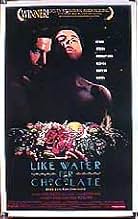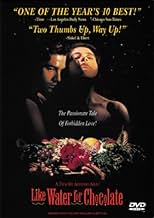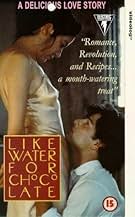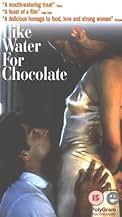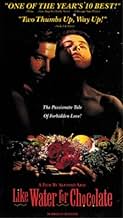VALUTAZIONE IMDb
7,1/10
19.923
LA TUA VALUTAZIONE
Dopo che l'uomo che ammira sposa la sorella, una giovane messicana riversa il suo amore nella cucina, scoprendo di poter trasferire le proprie emozioni grazie al cibo che prepara.Dopo che l'uomo che ammira sposa la sorella, una giovane messicana riversa il suo amore nella cucina, scoprendo di poter trasferire le proprie emozioni grazie al cibo che prepara.Dopo che l'uomo che ammira sposa la sorella, una giovane messicana riversa il suo amore nella cucina, scoprendo di poter trasferire le proprie emozioni grazie al cibo che prepara.
- Nominato ai 1 BAFTA Award
- 27 vittorie e 14 candidature totali
Recensioni in evidenza
This film had all the ingredients to be a great movie, however, it never materialized on screen. With so many interesting characters, it was disappointing that none of them except Tita connected in a meaningful way and evoked much emotion from from me. Pedro was a prime example of this. Instead of rooting for him, i found myself not only disinterested in his wimpy character but actually disliking him altogether.
Again, i thought this film had a great premise, but failed to deliver on screen. i truly loved the magical realism, and thought the director should have focused more on Titas ability to connect to people through food.
Again, i thought this film had a great premise, but failed to deliver on screen. i truly loved the magical realism, and thought the director should have focused more on Titas ability to connect to people through food.
10Jim B-2
Scenes of incredible beauty and humor. This film appeals to all of humankind's tastes (visual, intellectual, gustatory, sexual, etc.) It is one of the greatest romantic comedies showing the lives, values and beliefs of another culture ever presented as a gift to the American public. Be aware though that it is not an experience that will appeal to everyone. You won't enjoy it if you don't love food, have an imagination and understand that daytime soaps are not art.
Usually when I read a book, I am disappointed by the movie; there is so much more in the written word than can be put on screen. And when I see a movie I never want to read the book afterwards. This was the first movie that I read the book after seeing the movie; Como Agua Para Chocolate is THAT good a movie! And the book is WONDERFUL! The fairy tale aspect of this movie is told subtly, but with a strong Hispanic sense of mysticism-- you have the evil (step)mother, the heroine as Virgin Mary, who has magical powers, unrequited love, the unobtainable prince, and other classic fairy tale elements. This combines with the real elements of the Mexican Revolution and old world family practices revolving around family relations, martimony, and most of all cooking. Food plays a major role in this movie, but even more so in the book. I recommend both the book and the movie.
Tita (Lumi Cavazos) was born in the kitchen in 1895 Rio Grande, Mexico. After the death of her father, her mother vows to force her youngest Tita to care for her entire life. Tita grows up in the kitchen with servant Nacha. She falls in love with Pedro Muzquiz but her mother refuses to permit her to marry. Her mother offers older sister Rosaura and Pedro accepts hoping to stay close to Tita. Tita's tears infuse the wedding cake with her sadness.
This has a great magically realism. It's a fable of food, family, and passion. The story is fun and fanciful. Lumi Cavazos is a sweet endearing lead. The only drawback is the limited chemistry in the epic romance. It's probably asking too much. They don't have much time together before they have to be Romeo and Juliet. Then they have to be apart. It's submerged passion and Pedro doesn't always come across well.
This has a great magically realism. It's a fable of food, family, and passion. The story is fun and fanciful. Lumi Cavazos is a sweet endearing lead. The only drawback is the limited chemistry in the epic romance. It's probably asking too much. They don't have much time together before they have to be Romeo and Juliet. Then they have to be apart. It's submerged passion and Pedro doesn't always come across well.
Years ago, in California, I walked into a gas station convenience store to buy some consumable or other. The man who took my money was a Mexican emigre, and he saw that I was carrying a copy of the book Like Water for Chocolate by Laura Esquivel. He asked how I liked it, and I told him I was loving it. He told me not to miss the movie.
"Oh," I answered, "but I always worry that the movie will never be as good as the book."
"It doesn't matter," he told me. "This is a very great film. And it is the first real Mexican film I have ever seen shown in this country. You know, to everybody, not just the Mexican community."
I smiled and told him I would check it out, but honestly, I had no idea what he was talking about. After all, I knew who Dolores Del Rio and Cantinflas were, and the movies with them that I had seen were shown in L.A., to everybody.
But now, at last, I have seen this movie, and now, at last, I know what this guy was talking about. Like, wow! This really is a real Mexican film! Art! Cinema! More than just a bit of popular fluff!
Tender, compassionate and very witty, like the book on which it is based, this movie celebrates Mexican culture -- not just on the food, the preparation of which forms the premise of the story, but as kind of a rollicking take on the history of the young country at the turn of the century. It celebrates the music, the style of life on a ranch, the strength of the extended family, the beauty of the land, and the ethnic mixing pot that is every Mexican.
There is so much reckless joy and passionate love in this film, even when it portrays pain. It openly depicts female eroticism. (Plus, for a big change from US cinema, we get to see beautiful men and women of many shapes, sizes and colors all on the same screen.) The acting is flawless, and the star, Lumi Cavazos, is absolutely charming, full of life and credibility.
The only flaws I found in this film were minor and had to do with timing. For example, the final ascent to the climax seems to have been shortchanged a little bit. I would have liked to reach through this scene a little more slowly.
To judge Mexican cinema by the type of films I had seen before this one would be like judging U.S. cinema on the basis of Jerry Lewis or some cheesy melodramas from the '40s and '50s, but not taking into account any of our real film art. I'd love to know what else I've missed. Can't wait to find out.
"Oh," I answered, "but I always worry that the movie will never be as good as the book."
"It doesn't matter," he told me. "This is a very great film. And it is the first real Mexican film I have ever seen shown in this country. You know, to everybody, not just the Mexican community."
I smiled and told him I would check it out, but honestly, I had no idea what he was talking about. After all, I knew who Dolores Del Rio and Cantinflas were, and the movies with them that I had seen were shown in L.A., to everybody.
But now, at last, I have seen this movie, and now, at last, I know what this guy was talking about. Like, wow! This really is a real Mexican film! Art! Cinema! More than just a bit of popular fluff!
Tender, compassionate and very witty, like the book on which it is based, this movie celebrates Mexican culture -- not just on the food, the preparation of which forms the premise of the story, but as kind of a rollicking take on the history of the young country at the turn of the century. It celebrates the music, the style of life on a ranch, the strength of the extended family, the beauty of the land, and the ethnic mixing pot that is every Mexican.
There is so much reckless joy and passionate love in this film, even when it portrays pain. It openly depicts female eroticism. (Plus, for a big change from US cinema, we get to see beautiful men and women of many shapes, sizes and colors all on the same screen.) The acting is flawless, and the star, Lumi Cavazos, is absolutely charming, full of life and credibility.
The only flaws I found in this film were minor and had to do with timing. For example, the final ascent to the climax seems to have been shortchanged a little bit. I would have liked to reach through this scene a little more slowly.
To judge Mexican cinema by the type of films I had seen before this one would be like judging U.S. cinema on the basis of Jerry Lewis or some cheesy melodramas from the '40s and '50s, but not taking into account any of our real film art. I'd love to know what else I've missed. Can't wait to find out.
Lo sapevi?
- QuizThe original literal title means very little outside Mexico (it refers to the exact boiling temperature water needs to reach in order to make hot chocolate). Therefore, in France the title has been changed into "Bitter Chocolate", in Poland into "Quails in Rose Petals" and in Japan into "The Legend of the Rose Petal Sauce".
- BlooperWhen Dr. Brown holds up a piece of white phosphorus, nothing happens. White phosphorus ignites in air at room temperature, however, so it should have been shown burning.
- Versioni alternativeThe International version is color-corrected, and some voices were re-dubbed in the English spoken language scenes. Includes sex & nudity scenes.
- ConnessioniFeatured in The 50th Annual Golden Globe Awards (1993)
- Colonne sonoreMi Querida Capitan
Written by José Alfonso Palacios
I più visti
Accedi per valutare e creare un elenco di titoli salvati per ottenere consigli personalizzati
- How long is Like Water for Chocolate?Powered by Alexa
Dettagli
- Data di uscita
- Paese di origine
- Siti ufficiali
- Lingue
- Celebre anche come
- Como agua para chocolate
- Luoghi delle riprese
- Aziende produttrici
- Vedi altri crediti dell’azienda su IMDbPro
Botteghino
- Budget
- 2.000.000 USD (previsto)
- Lordo Stati Uniti e Canada
- 21.665.468 USD
- Fine settimana di apertura Stati Uniti e Canada
- 23.600 USD
- 21 feb 1993
- Lordo in tutto il mondo
- 21.744.201 USD
- Tempo di esecuzione1 ora 45 minuti
- Colore
- Mix di suoni
- Proporzioni
- 1.85 : 1
Contribuisci a questa pagina
Suggerisci una modifica o aggiungi i contenuti mancanti



